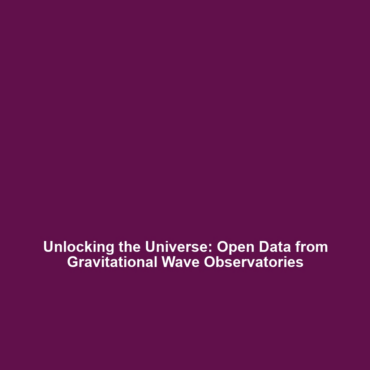Understanding Black Holes with Gravitational Waves: How Waves Reveal Black Hole Properties
Introduction
Gravitational waves have revolutionized our understanding of astrophysics, particularly in the study of black holes. These ripples in spacetime illuminate the vast mysteries surrounding black hole formation, collision, and characteristics. By analyzing the properties of gravitational waves generated from such cosmic events, researchers can glean critical insights into the nature of black holes. This article explores how gravitational waves serve as a powerful tool in revealing fundamental information about black holes, providing an essential framework for future research and enhancing our comprehension of the universe.
Key Concepts
To effectively understand how gravitational waves relate to black holes, it is crucial to explore some fundamental concepts:
Gravitational Waves Explained
Gravitational waves are disturbances in spacetime produced by the acceleration of massive objects, such as colliding black holes or neutron stars. These waves carry significant information about their origins, allowing astrophysicists to study phenomena that are otherwise invisible through traditional astrophysical observations.
Black Holes and Their Properties
Black holes are regions in space where gravitational forces are so intense that nothing, not even light, can escape. By analyzing the gravitational waves created during black hole mergers, scientists can infer various properties, including:
- Mass: The total mass of the merging black holes.
- Spin: The rotation rates of the black holes.
- Formation Models: Insight into the formation processes of these celestial objects.
Applications and Real-World Uses
The study of gravitational waves has practical applications that extend beyond theoretical astrophysics:
- Detection of Black Hole Mergers: Gravitational wave observatories like LIGO and Virgo have successfully detected numerous black hole mergers, offering invaluable data for astrophysical studies.
- Testing General Relativity: Gravitational waves provide a platform to test Einstein’s theories under extreme gravitational conditions, enhancing our understanding of fundamental physics.
- Cosmic Distance Scale: By studying gravitational wave events, researchers can improve methods for measuring distances in the universe.
Current Challenges
Despite the progress made in understanding black holes through gravitational waves, several challenges persist within this field:
- Limited Detection Range: Current detectors are only sensitive to events within specific distances, potentially missing far-off mergers.
- Signal Noise: Disturbances from terrestrial and cosmic sources can interfere with the subtle signals emitted by gravitational waves.
- Data Interpretation: Analyzing the complex data from multiple detectors requires advanced algorithms and significant computational resources.
Future Research and Innovations
The future of researching black holes using gravitational waves is bright, with several anticipated innovations:
- Advanced Detector Technology: Next-generation detectors like LIGO-India and the proposed Einstein Telescope aim to enhance sensitivity and reliability.
- Multi-Messenger Astronomy: The integration of gravitational wave data with electromagnetic observations promises to create a comprehensive picture of cosmic events.
- AI and Machine Learning: These technologies are likely to revolutionize data analysis, improving the efficiency of detecting and interpreting gravitational waves.
Conclusion
In summary, gravitational waves have become a pivotal focus in the ongoing quest to understand black holes and their properties. Through the detection and analysis of these waves, researchers can uncover fundamental truths about the universe’s most enigmatic objects. As we anticipate future advancements in this field, the potential for groundbreaking discoveries remains high. For further insights into gravitational waves and their significance, check out our related articles on gravitational wave detection and black hole formation theories.




